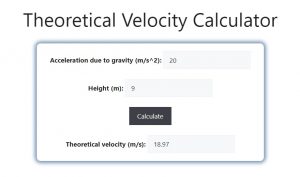About Theoretical Velocity Calculator (Formula)
In physics, understanding the velocity of a falling object is crucial for various applications, from engineering to sports. The Theoretical Velocity Calculator helps determine the speed at which an object will hit the ground when dropped from a specific height. This calculation is grounded in the principles of gravitational potential energy and kinetic energy. Knowing the theoretical velocity is essential for safety assessments, design calculations, and various scientific analyses. This article will guide you through the formula, how to use the calculator, and answer frequently asked questions related to theoretical velocity.
Formula
The formula for calculating theoretical velocity is: v = √(2gh). In this formula, v represents the velocity in meters per second, g is the acceleration due to gravity (approximately 9.81 m/s²), and h is the height in meters from which the object is dropped.
How to Use
To use the Theoretical Velocity Calculator, follow these steps:
- Input the height (h) from which the object will fall in meters.
- Click the “Calculate” button.
- The calculator will then compute and display the theoretical velocity (v) of the object in meters per second.
Example
For instance, if an object is dropped from a height of 20 meters, the calculation would be as follows:
- Height (h) = 20 m
- Using the formula: v = √(2gh)
- v = √(2 * 9.81 * 20) ≈ 19.80 m/s
This means that the object will hit the ground at a theoretical velocity of approximately 19.80 meters per second.

FAQs
- What is theoretical velocity?
Theoretical velocity is the speed an object would reach when falling freely under the influence of gravity from a certain height, ignoring air resistance. - Why is air resistance not considered?
Air resistance is typically negligible in theoretical calculations, but it can significantly affect actual velocity in practical scenarios, especially for lighter objects. - What is the value of ‘g’ in the formula?
The value of ‘g’ is the acceleration due to gravity, which is approximately 9.81 m/s² on the surface of the Earth. - How can I convert height from feet to meters?
To convert feet to meters, multiply the height in feet by 0.3048. - Is the calculator accurate for all heights?
The calculator provides theoretical values, and accuracy decreases with higher altitudes or when significant air resistance is present. - Can this formula be used for any object?
Yes, this formula applies to any object in free fall, assuming it is dropped from rest and there are no other forces acting on it. - What happens if I input a negative height?
Inputting a negative height is invalid, as height cannot be negative in this context. - Does the object’s mass affect the theoretical velocity?
No, mass does not affect the theoretical velocity when only gravitational force is considered, as all objects fall at the same rate in a vacuum. - What is the significance of this calculation in engineering?
Understanding theoretical velocity helps engineers design safe structures and systems by predicting the impact forces of falling objects. - Can I use this calculation for projectiles?
The formula is specifically for free-fall scenarios; for projectiles, additional factors must be considered, including launch angle and initial velocity. - Is there a way to calculate velocity considering air resistance?
Yes, more complex physics models consider drag force and other variables to estimate the velocity of falling objects accurately. - How does this apply in real-life situations?
It can help assess the safety of falling objects in construction, amusement parks, and other environments where falling hazards are present. - What is the difference between theoretical and actual velocity?
Theoretical velocity is the ideal speed without resistance, while actual velocity considers real-world factors like air resistance and friction. - Can I apply this formula to liquids or gases?
This formula specifically applies to solids in free fall; fluids behave differently under gravitational forces. - How do I determine the height of a fall?
Height can be measured directly or calculated based on the position of an object above the ground. - What tools can I use to measure height?
Tools like measuring tapes, laser distance measurers, or altimeters can accurately measure height. - Does the calculator work for heights in different units?
The calculator is designed for height in meters; ensure to convert other units to meters for accurate results. - Can this formula be used for calculating escape velocity?
No, escape velocity is a different concept that requires different calculations based on gravitational potential energy. - What other applications does theoretical velocity have?
It is used in fields such as physics education, safety engineering, and impact analysis in various industries. - Is there a limit to how high I can drop an object for this calculation?
While there is no theoretical limit, practical considerations such as air resistance and atmospheric conditions affect outcomes at extreme heights.
Conclusion
The Theoretical Velocity Calculator is a valuable tool for understanding the principles of motion and the effects of gravity on falling objects. By utilizing this calculator, users can gain insights into how height influences speed and learn essential concepts in physics. Whether for educational purposes, safety assessments, or engineering applications, understanding theoretical velocity is fundamental. Utilize the calculator to enhance your knowledge and application of physics in real-world scenarios!
